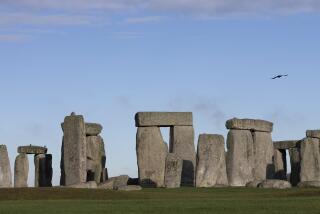Arthurian Legend Gets Archeological Link to Reality
- Share via
LONDON — An ancient slate inscribed with a name similar to that of England’s King Arthur has been found at Tintagel, the ruined castle where the legendary leader of the knights of the round table is said to have been born.
English Heritage, the government’s conservation agency, said last week that the 6th-century slate bore the inscription “Artognov,” the Latin form of a British name “Arthnou.”
“By extraordinary coincidence the stone bears similarities to the name of the mythical King Arthur, long associated with Tintagel,” English Heritage said.
“This adds a new dimension to the debate about the possibility of there having been a real Arthur on whom the mythical figure was based,” it added.
English Heritage’s chief archeologist, Geoffrey Wainwright, said that although there is no evidence to link the stone with either the historical or the legendary figure of Arthur, it is “the find of a lifetime.”
Even if the stone has nothing to do with the Arthurian legend of Camelot or the quest for the Holy Grail, the centuries have not treated it kindly.
English Heritage said it had been broken in half and used as a drain cover.
King Arthur was probably a Romano-British leader in the wars against the Saxon invaders. He holds chief place in English literature of heroic imagination and a great body of legend grew around him, his knights, their quest for the Holy Grail, and his famous round table.
More to Read
Sign up for Essential California
The most important California stories and recommendations in your inbox every morning.
You may occasionally receive promotional content from the Los Angeles Times.











